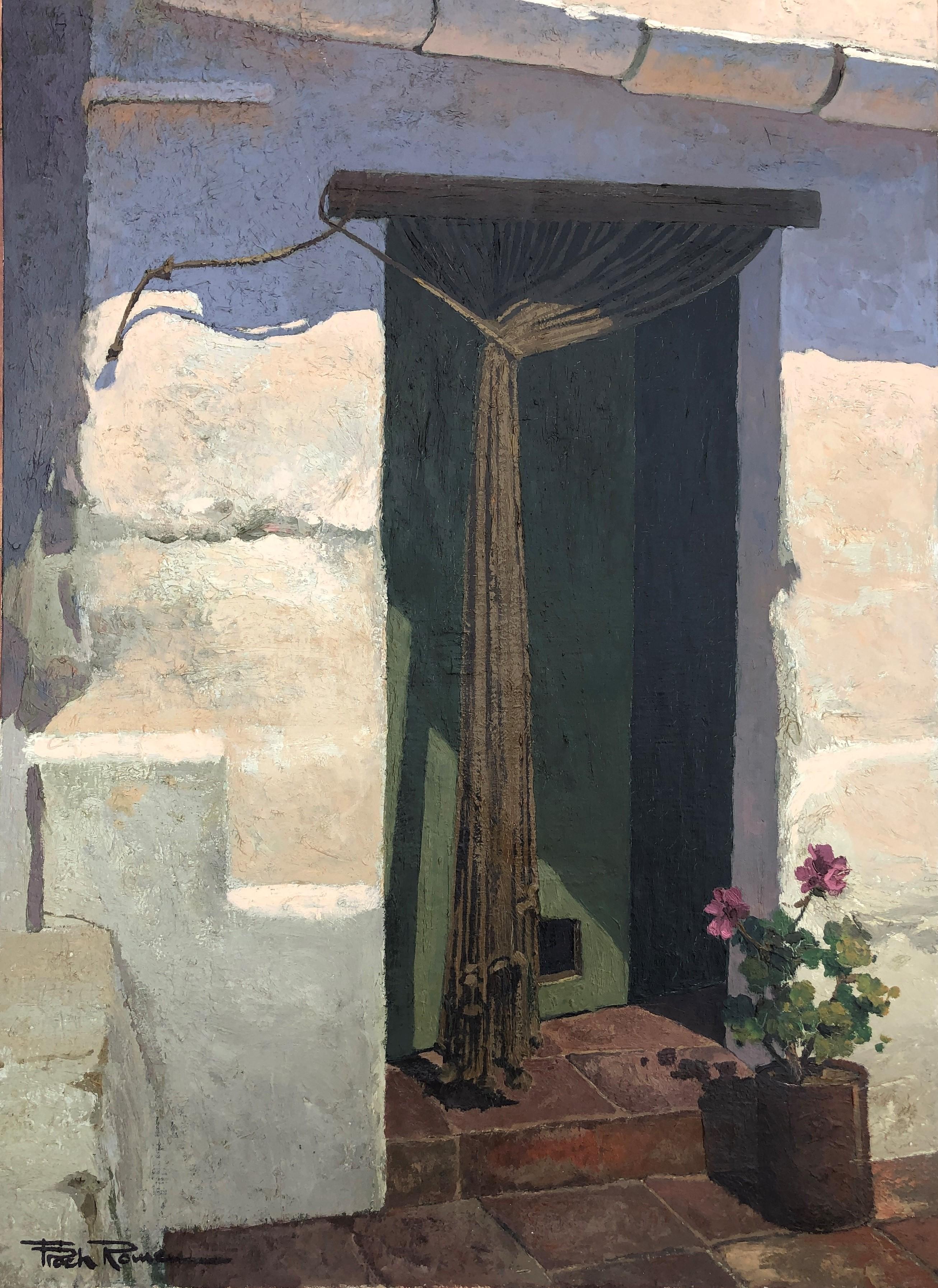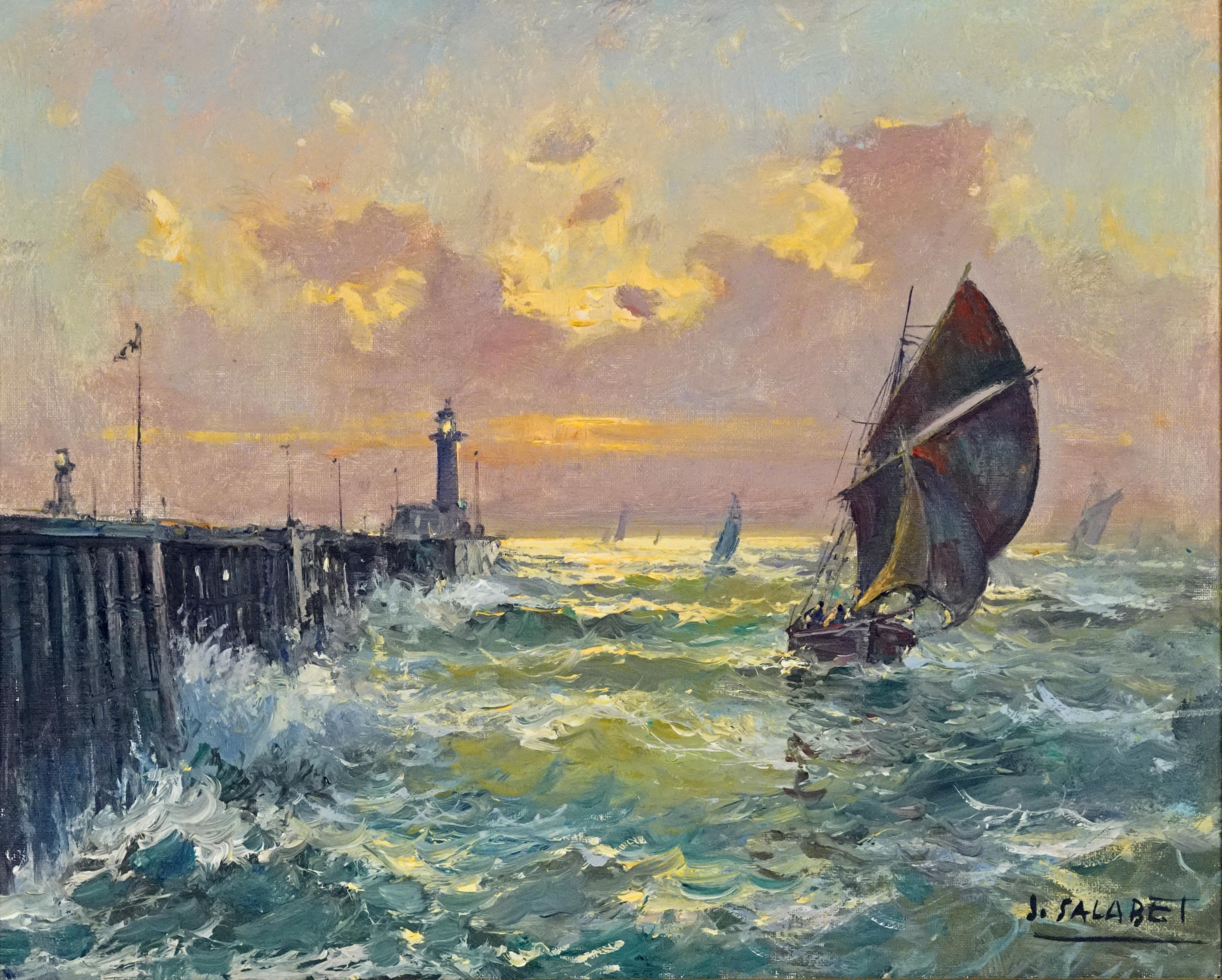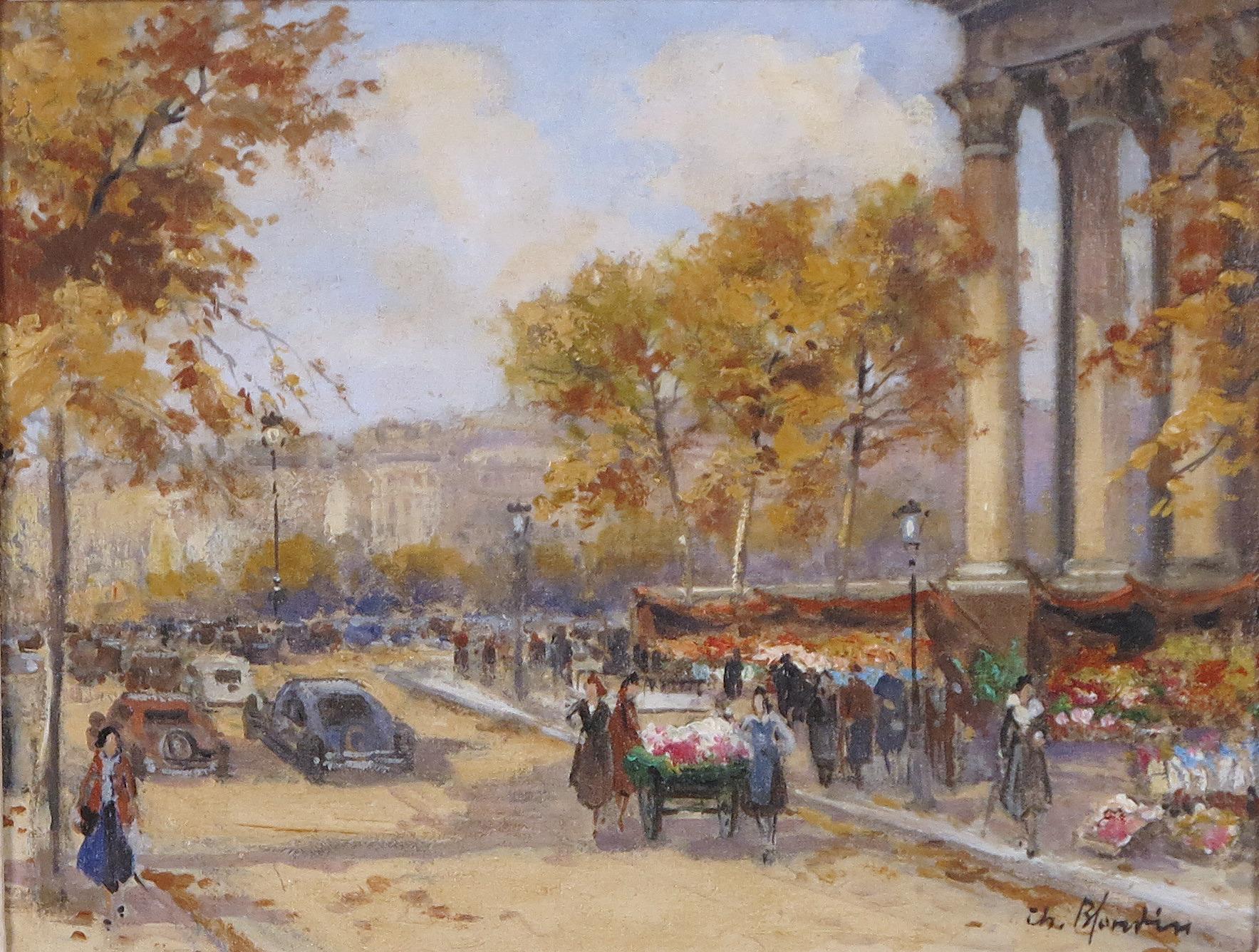Anton Otto FischerSummer Seas1945
1945
About the Item
- Creator:Anton Otto Fischer (1882 - 1962, German)
- Creation Year:1945
- Dimensions:Height: 32.5 in (82.55 cm)Width: 38.5 in (97.79 cm)Depth: 2 in (5.08 cm)
- Medium:
- Movement & Style:
- Period:
- Condition:
- Gallery Location:Sheffield, MA
- Reference Number:
Anton Otto Fischer
The marine paintings by Anton Otto Fischer are as authoritative as only a working sailor could make them.
Born in Munich, Germany, but orphaned as a boy, Fischer ran away to sea at 16 and spent eight years before the mast on a variety of sailing ships. Paid off in New York, he stayed to apply for American citizenship and to teach seamanship on the school ship, St. Mary's. He later served as a hand on racing yachts on Long Island Sound and worked as a model and handyman for the illustrator A.B. Frost. When he had saved enough money, he spent two years at the Académie Julian in Paris under Jean-Paul Laurens.
Returning to the United States, Fischer sold his first picture to Harper's Weekly in 1908, around the time he moved to Wilmington to receive critiques from Howard Pyle. Everybody's Magazine sent him the first of several Jack London stories. In 1910, he began a 48–year association with The Saturday Evening Post, which included illustrating serialized characters such as Peter B. Kyne's "Crappy Ricks," Norman Reilly Raine's "Tugboat Annie," Guy Gilpatrick's "Glencannon," as well as serials for Kenneth Robert and Nordhoff and Hall.
In 1942, he was given the rank of Lieutenant Commander as "Artist Laureate" for the United States Coast Guard and was assigned North Atlantic convoy duty on the Coast Guard cutter Campbell during the winter of 1943. The Campbell was disabled during a successful attack on a German U-boat, and Fischer's dramatic paintings of this experience were published by Life magazine. The pictures are now in the Coast Guard Academy at New London, Connecticut.
In 1947, Fischer wrote and illustrated a book about his earlier sailing years, entitled Focs'le Days: A Story of My Youth, published by Charles Scribner's Sons.
Find original Anton Otto Fischer paintings and prints on 1stDibs.
(Biography provided by The Illustrated Gallery)
- ShippingRetrieving quote...Ships From: Sheffield, MA
- Return PolicyThis item cannot be returned.
- Lighthouse At FecampBy Jean SalabetLocated in Sheffield, MAJEAN SALABET French B.1900 Lighthouse At Fecamp Oil on canvas Signed lower right 13 by 16 in. W/frame 19 by 22 in. Jean Salabet was a School of Paris painter know for his colorfu...Category
1950s Post-War Landscape Paintings
MaterialsOil
- Marche des Fleurs Devant La MadelineBy Charles BlondinLocated in Sheffield, MACharles Blondin French, 1913-1991 Marche des Fleurs Devant La Madeline Oil on canvas Signed lower right 11 by 14 in. W/frame 16 by 19 in. A "School of Paris" artist during the mid...Category
1950s Post-War Landscape Paintings
MaterialsOil
- Aux CafeBy Charles BlondinLocated in Sheffield, MACharles Blondin French, 1913-1991 Aux Cafe Oil on canvas Signed lower right 11 by 14 in. W/frame 16 by 19 in. A "School of Paris" artist during the mid-20th century, Charles Blond...Category
1950s Post-War Landscape Paintings
MaterialsOil
- Flower Market, La Madeleine, ParisBy Antoine BlanchardLocated in Sheffield, MAAntoine Blanchard French, 1910-1988 Flower Market, La Madeleine, Paris Oil on canvas 13 by 18 in. W/frame 19 by 24 in. Signed lower right Provenance: Catalda Fine Arts, Inc., New York Private Collection, New York Trinity House Paintings, London Private Collcetion, New York Alexander Avenard Collection Le Trianon...Category
Mid-20th Century Post-Impressionist Landscape Paintings
MaterialsOil
- Woman and ChildBy John Edward CostiganLocated in Sheffield, MAJohn Edward Costigan, N.A. American, 1888-1972 Woman and Child Oil on canvas Signed ‘J.E. Costigan N.A.’ lower left 24 by 30 in. W/frame 32 by 38 in. John Costigan was born of Irish-American parents in Providence, Rhode Island, February 29, 1888. He was a cousin of the noted American showman, George M. Cohan, whose parents brought the young Costigan to New York City and was instrumental in starting him on a career in the visual arts. They were less successful in encouraging him to pursue formal studies at the Art Students League (where, however, he later taught) than in exposing him to the commercial art world through the job they had gotten him with the New York lithographing firm that made their theatrical posters. At the H. C. Miner Lithographing Company, Costigan worked his way up from his entry job as a pressroom helper, through various apprenticeships, to the position of sketch artist. In the latter capacity he was an uncredited designer of posters for the Ziegfeld Follies and for numerous silent films. Meanwhile, he had supplemented his very meager formal studies in the fine arts with a self-teaching discipline that led to his first professional recognition in 1920 with the receipt of prizes for an oil painting and watercolor in separate New York exhibitions. A year earlier, Costigan had wed professional model Ida Blessin, with whom he established residence and began raising a family in the sleepy little rural New York hamlet of Orangeburg, the setting for the many idyllic farm landscapes and wood interiors with which he was to become identified in a career that would span half a century. John Costigan’s first national recognition came in 1922 with his winning of the coveted Peterson Purchase prize of the Art Institute of Chicago for an oil on canvas, “Sheep at the Brook.” It marked the start of an unbroken winning streak that would gain him at least one important prize per year for the remainder of the decade. The nation’s art journalists and critics began to take notice, making him the recurring subject of newspaper features and magazine articles. The eminent author and critic Edgar Holger Cahill was just a fledgling reporter when he wrote his first feature, “John Costigan Carries the Flame,” for Shadowland Magazine in 1922. Costigan had his first one-man show of paintings at the Rehn Gallery on New York’s 5th Avenue in November, 1924, to be followed less than three years later by another at the Art Institute of Chicago. In addition, Costigan’s work has been—and continues to be included, side-by-side with that of some of America’s most high-profile artists, in museum and gallery exhibitions throughout the country. His renown had peaked in the early 1930s, by which time his work had been honored with nearly every major award then being bestowed in the fine arts and had been acquired for the permanent collections of several prestigious American museums, including New York’s Metropolitan (which only recently, in 1997, deaccessioned his “Wood Interior,” acquired in 1934). Although Costigan’s celebrity had ebbed by the late 1930s, the Smithsonian Institution saw fit in 1937 to host an exhibition exclusively of his etchings. And, in 1941, the Corcoran Gallery (also Washington, D.C.) similarly honored him for his watercolors. (Another Washington institution, the Library of Congress, today includes 22 Costigan etchings and lithographs in its permanent print collection.) During World War II, Costigan returned briefly to illustrating, mainly for Bluebook, a men’s pulp adventure magazine. A gradual revival of interest in his more serious work began at the end of the war, culminating in 1968 with the mounting of a 50-year Costigan retrospective at the Paine Art Center and Arboretum in Oshkosh, Wisconsin. Oils, watercolors and prints were borrowed from museums and private collections throughout the country, and the exhibition was subsequently toured nationally by the Smithsonian Institution. John Costigan died of pneumonia in Nyack, NY, August 5, 1972, just months after receiving his final prestigious award —the Benjamin West Clinedinst Medal of the Artist’s Fellowship, Inc., presented in general recognition of his “...achievement of exceptional artistic merit...” in the various media he had mastered in the course of his career. This painting depicts one of the artist's favorite themes --the farm family bathing...Category
1940s Post-Impressionist Landscape Paintings
MaterialsOil
- Marche de Fleurs, a La Madeleine Paris 1954By Jean SalabetLocated in Sheffield, MAJean Salabet French, 20th Century Marche de Fleurs, La Madeleine Paris Jean Salabet was a School of Paris painter know for his colorful Parisia...Category
1950s Post-Impressionist Landscape Paintings
MaterialsOil
- Gondolas in Venice Italy oil on canvas paintingBy Jose Luis Florit RoderoLocated in Barcelona, BarcelonaJosé Luis Florit Rodero (1909-2000) - Venice Venezia Italy - Oil on canvas Oil measures 50x61 cm. Frameless. José Luis Florit Rodero (Madrid, 1909-Pa...Category
1980s Post-War Landscape Paintings
MaterialsOil, Canvas
- Menorca portal Spain oil on canvas paintingBy Francesc Poch RomeuLocated in Barcelona, BarcelonaPoch Romeu was one of the most relevant and renowned landscape painters who originated in the second half of the 20th century. His technique was oil on can...Category
1980s Post-War Landscape Paintings
MaterialsOil, Canvas
- Industry Along the RiverBy Joseph WolinsLocated in Wiscasett, MESigned lower left, dimensions listed include the frame. Joseph Wolins was born in Atlantic City, New Jersey in 1915. He studied at the National Academy of Design from 1935 to 1941 un...Category
1950s Post-War Landscape Paintings
MaterialsOil
- Electro Car Go (American Post-War, Impressionist, Boston, Streetcar, Tram)Located in Kansas City, MOAlex Tschernjawski Electro Car Go (American Post-War, Impressionist, Boston, Streetcar, Tram, Cityscape, Blue Hill, Dorchester, Mattapan Square, Fra...Category
1960s Post-War Landscape Paintings
MaterialsCanvas, Oil
- Winter's Snowy Tatra Mountains with Pines and StreamBy Laszlo NeogradyLocated in Soquel, CAWinter's Snowy Tatra Mountains with Pines and Stream Beautiful post-war winter snowy scene with mountains and pine by Laszlo Neogrady (Hungarian, 1896-1962), circa 1940. Lovely textu...Category
1940s Post-War Landscape Paintings
MaterialsLinen, Oil
- Mid Century Mexican Street Scene -- Jardin Del ArteLocated in Soquel, CAWonderful mid century Mexico street scene by Hector Lara Orozco (Mexican, 1892 - 1958), 19a65. Orozco is a Mexican postwar & contemporary artist. Unfra...Category
1960s Post-War Landscape Paintings
MaterialsLinen, Oil





